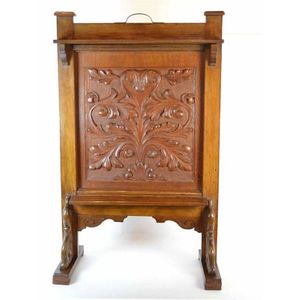Chippendale Style Oak Pedestal Desk, 1920s
You must be a subscriber, and be logged in to view price and dealer details.
Subscribe Now to view actual auction price for this item
When you subscribe, you have the option of setting the currency in which to display prices to $Au, $US, $NZ or Stg.
- Oak - Native to Europe and England, oak has been used for joinery, furniture and building since the beginning of the medieval civilisation. It is a pale yellow in colour when freshly cut and darkens with age to a mid brown colour.
Oak as a furniture timber was superceded by walnut in the 17th century, and in the 18th century by mahogany,
Semi-fossilised bog oak is black in colour, and is found in peat bogs where the trees have fallen and been preserved from decay by the bog. It is used for jewellery and small carved trinkets.
Pollard oak is taken from an oak that has been regularly pollarded, that is the upper branches have been removed at the top of the trunk, result that new branches would appear, and over time the top would become ball-like. . When harvested and sawn, the timber displays a continuous surface of knotty circles. The timber was scarce and expensive and was used in more expensive pieces of furniture in the Regency and Victorian periods. - Frieze - An architectural term denoting the flat, shaped or convex horizontal surface of furniture, between the architrave and the cornice, usually found on a cabinet or bookcase, or on desks and tables where it may include drawers, the area between the top and the legs. In ceramics, the term refers to the banding, of usually a repeating pattern, on the rims of plates and vases.
- Circa - A Latin term meaning 'about', often used in the antique trade to give an approximate date for the piece, usually considered to be five years on either side of the circa year. Thus, circa 1900 means the piece was made about 1900, probably between 1895 and 1905. The expression is sometimes abbreviated to c.1900.
- Lion's Paw - The decorative lion's paw has been used in furniture, silver, and ceramics for centuries. It is a stylized representation of the paw of a lion, often depicted in a highly realistic or stylized form.
In furniture design, lion's paws were popular in the neoclassical and Empire styles of the late 18th and early 19th centuries. They were often used as feet on tables, chairs, and other pieces of furniture. The lion's paw was a popular motif for furniture makers because it added a sense of grandeur and regalness to their pieces.
In silverware design, the lion's paw was often used on the feet of tea and coffee pots, as well as on other pieces of silverware such as wine coolers and tureens. The lion's paw was often used in combination with other neoclassical motifs, such as acanthus leaves or grape clusters, to create a sense of grandeur and classical elegance.
In ceramics, lion's paws were commonly used as feet on vases, urns, and other pottery items. The lion's paw was often depicted in relief or as a highly stylized form, and was sometimes used in combination with other decorative elements, such as garlands or swags. - Pedestal Desk - A pedestal desk is a type of desk that consists of a large work surface supported by two pedestals or cabinets, one on either side. The pedestals are usually identical and contain drawers and cabinets for storage. The desk's design allows it to be placed in the centre of a room, as the back of the desk is usually finished with the same veneer as the front.
Pedestal desks were popular in the 18th and 19th centuries, and were usually made from high-quality wood, such as cedar, mahogany, walnut or oak, and were decorated with intricate carvings and other decorative details. They were used by businessmen, politicians, and other professionals, and were considered a symbol of status and success. - Apron - A decorative wooden panel that sits underneath the top surface of a table or chair, and unites the top of the piece with the legs, running at right angles to the underside. On carcase furniture such as a chest or wardrobe, the apron sits below the drawers or doors and attaches to the legs.
On carcase furniture without legs the panel under the drawers or doors sits on the floor and is termed a plinth.
An apron can provide a decorative touch to an otherwise unadorned piece of furniture and at the same time provide structural support and strength. They can be carved or pierced and quite elaborate. - Pedestal - The columns that support many dining tables and most small occasional tables. They are usually turned, though octagonal-shaped pedestals were fashionable during the 1830s and 1840s.
This item has been included into following indexes:
Visually similar items

A Victorian burr walnut and inlay veneer davenport, by Robert Strahan, Dublin, mid 19th century, with single door side cupboard containing 4 pullout drawers; opposite side single door cupboard with one interior shelf; the cabinet base upon ceramic castors.

A West Australian Arts & Crafts style jarrah and Sheoak fire screen, early 20th century school of William Howitt (1846-1928), probably by one of his students the central sheoak panel decorated with carved acanthus leaves and scroll motifs. Height 83 cm, wi

A James II oak coffer, typical in design featured a geometric panelled front

A French carved upright cabinet, cupboard below and two drawers above. 103 cm high, 60 cm wide, 45 cm deep.
